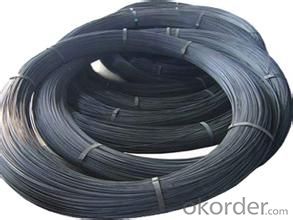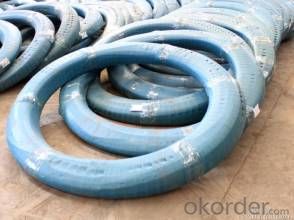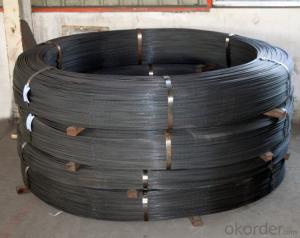Alloy Strand Steel Wires
- Loading Port:
- China Main Port
- Payment Terms:
- TT or LC
- Min Order Qty:
- -
- Supply Capability:
- -
OKorder Service Pledge
OKorder Financial Service
You Might Also Like
Quick Details
| Steel Grade: | SWRH77B, SWRH82B | Standard: | ASTM,BS,GB,JIS | Wire Gauge: | 4.0mm-10.0mm |
| Place of Origin: | Tianjin China (Mainland) | Type: | Drawn Wire,Spiral/Helical Ribs, Round Plain | Application: | Construction |
| Alloy Or Not: | Is Alloy | Special Use: | Free Cutting Steel | Model Number: | 4.0-10.0mm |
| Product Name: | prestressed steel wire 4mm high carbon steel wire | Size: | 4.0-10.0mm | ||
| Strength: | 1570/1670/1770/1860 N/mm2 | Relaxation: | Less than 2% (1000hour) | Elongation: | Not less than 4% |
| MOQ: | 10 Tons | Payment: | TT, LC | Delivery: | 10-15 work days |
| Package: | As your requirements |
Packaging & Delivery
| Packaging Detail:steel strand coil to be packed in damp proof materials strapped with 8 bands on one wooded pallet with an outer layer of plastic used for anti-rainshower 2 or 3 wooden block undermeath each coil. | |
| Delivery Detail:within 2 weeks |
Specifications
high carbon class A steel wire
Constructon:7 steel wire
material:wire 82B
FAQ of Alloy Strand Steel Wires
①How is the quality of your products?
Our products are manufactured strictly according to national and internaional standard, and we take a test
on each product before delivered out. If you want see our quality certifications and all kinds of testing report, please just ask us for it.
Guaranteed: If products’ quality don’t accord to discription as we give or the promise before you place order, we promise 100% refund.
②How about price?
Yes, we are factory and be able to give you lowest price below market one, and we have a policy that “ for saving time and absolutely honest business attitude, we quote as lowest as possible for any customer, and discount can be given according to quantity”,if you like bargain and factory price is not low enough as you think, just don’t waste your time.Please trust the quotation we would give you, it is professional one.
③Why should you chose us?
Chose happens because of quality, then price, We can give you both.Additionally, we can also offer professional products inquiry, products knowledge train(for agents), smooth goods delivery, exellent customer solution proposals.Our service formula: good quality+good price+good service=customer’s trust
SGS test is available, customer inspection before shipping is welcome, third party inspection is no problem.
Alloy Strand Steel Wires Images


Any question, pls feel free to contact us !
- Q:What are the common joining methods for steel wire rod?
- The common joining methods for steel wire rod include welding, soldering, crimping, and using mechanical connectors such as bolts or clips.
- Q:What are the standard fatigue resistance requirements for steel wire rod?
- The standard fatigue resistance requirements for steel wire rod vary depending on the specific application and industry standards. However, there are some general guidelines that can be considered. In industries such as automotive, aerospace, and construction, fatigue resistance is a critical factor in determining the reliability and durability of steel wire rods. These rods are subjected to cyclic loading and stress, which can lead to fatigue failure if the material is not designed to withstand these conditions. The fatigue resistance requirements for steel wire rods are typically determined by conducting fatigue tests, such as rotating bending or axial fatigue tests. These tests involve subjecting the wire rod to repeated cycles of loading and unloading under specific conditions, such as stress amplitude and frequency. The fatigue resistance of steel wire rods is often quantified using parameters such as fatigue strength, fatigue life, and fatigue limit. The fatigue strength represents the maximum stress level at which the wire rod can withstand a specified number of cycles without failure. The fatigue life indicates the number of cycles that the wire rod can sustain before failure occurs. The fatigue limit, also known as endurance limit, is the stress level below which the wire rod can theoretically endure an infinite number of cycles without failure. The specific fatigue resistance requirements for steel wire rods can vary depending on factors such as the intended use, the material composition, and the expected service life. These requirements are typically defined by industry standards and specifications, such as those set by organizations like the American Society for Testing and Materials (ASTM) or the International Organization for Standardization (ISO). It is important for manufacturers and engineers to carefully consider the fatigue resistance requirements for steel wire rods to ensure the safety and reliability of the final products. This often involves selecting the appropriate material grade, conducting thorough testing and analysis, and adhering to industry standards and specifications.
- Q:How is steel wire rod used in the production of wire mesh for mining and quarrying applications?
- Steel wire rod is used in the production of wire mesh for mining and quarrying applications by being drawn into thin wires and then woven or welded together to create a strong and durable mesh structure. This mesh is then used to reinforce tunnels, protect equipment, and provide safety barriers in mining and quarrying operations.
- Q:What is the average diameter of steel wire rod?
- The average diameter of steel wire rod varies depending on its intended application and industry standards. However, it typically ranges from 5.5 millimeters to 14 millimeters.
- Q:How is steel wire rod used in the manufacturing of wire rope fittings?
- Steel wire rod is used in the manufacturing of wire rope fittings as it acts as the raw material for producing wire ropes. The wire rod is first drawn into the desired diameter and then twisted into strands, which are further twisted together to form a wire rope. These wire ropes are then utilized in various applications such as lifting and rigging, securing loads, and supporting structures. The quality and strength of the wire rod directly impact the performance and durability of the wire rope fittings, making it an essential component in their manufacturing process.
- Q:How is steel wire rod inspected for dimensional accuracy?
- Steel wire rod is inspected for dimensional accuracy using various techniques. One common method is through the use of calipers and micrometers, which measure the diameter of the rod at different points to ensure it meets the specified tolerances. Additionally, laser-based measurement systems can be employed to precisely analyze the rod's dimensions. These techniques help ensure that the steel wire rod meets the required standards and can be used effectively in various applications.
- Q:How is steel wire rod used in the manufacturing of electrical cables?
- Steel wire rod is commonly used in the manufacturing of electrical cables due to its excellent strength and conductivity properties. The wire rod is typically drawn through a series of dies to reduce its diameter and increase its length. This process, known as wire drawing, results in a fine, high-quality wire that can be used as a conductor in electrical cables. The steel wire rod serves as the core conductor of the cable, providing a path for the electrical current to flow. Its high conductivity ensures minimal power loss during transmission, making it an ideal choice for electrical applications. Additionally, the strength of steel wire rod allows for the cable to withstand mechanical stress and strain, ensuring its durability and longevity. In the manufacturing process, the steel wire rod is often coated with a layer of insulation material, such as PVC or polyethylene, to provide electrical insulation and protect against moisture and other environmental factors. This insulation layer prevents short circuits and ensures the safe and efficient transmission of electricity. Furthermore, steel wire rod is also used in the armor layer of certain types of electrical cables. By wrapping the wire rod around the core conductor, it provides additional mechanical protection to the cable, making it more resistant to bending, crushing, and external impacts. Overall, steel wire rod plays a crucial role in the manufacturing of electrical cables by providing a strong and conductive core conductor. Its use ensures the safe and reliable transmission of electricity while maintaining the structural integrity of the cable.
- Q:What are the different types of wire rods for reinforcement made from steel wire rod?
- Wire rods for reinforcement, which are made from steel, come in several different types. These include: 1. Mild Steel Wire Rods: The most commonly used type, these wire rods are made from low carbon steel. They offer good strength and durability, making them suitable for various applications. 2. High Tensile Steel Wire Rods: Specifically designed to provide greater strength and resistance to tension, these wire rods are made from high carbon steel. They are commonly used in construction projects or the manufacturing of heavy machinery. 3. Stainless Steel Wire Rods: Made from corrosion-resistant stainless steel, these wire rods are commonly used in environments prone to corrosion, like coastal areas or chemical processing plants. 4. Galvanized Steel Wire Rods: To protect against corrosion, these wire rods are coated with a layer of zinc. They are often used in outdoor applications or areas with high moisture levels. 5. Copper-Clad Steel Wire Rods: These wire rods have a steel core with a layer of copper cladding. They combine the strength and durability of steel with the excellent electrical conductivity of copper, making them ideal for electrical wiring or grounding systems. In conclusion, the different types of wire rods for reinforcement made from steel offer a range of properties and characteristics to suit various applications and environments.
- Q:How is steel wire rod used in the manufacturing of pre-stressed concrete?
- Pre-stressed concrete relies heavily on steel wire rod, an essential component in its manufacturing process. This type of concrete is reinforced with steel cables or bars to enhance its structural strength and durability. Steel wire rod serves as the primary material for producing these steel cables or bars. To manufacture pre-stressed concrete, the steel wire rods undergo a series of processes. Initially, they are drawn through dies to decrease their diameter and increase their tensile strength. This technique, known as cold drawing, results in a wire that is smooth, consistent, and possesses a high strength-to-weight ratio. Afterward, the wire rods are coiled for ease of handling and transportation. In the creation of pre-stressed concrete, the steel wire rod is further processed into strands or individual wires. These strands or wires are then embedded into the concrete structure before it solidifies. Hydraulic jacks are used to tension the steel wires, applying a force greater than the anticipated load the concrete will bear throughout its service life. This tensioning process helps counteract the tensile stresses inherent to concrete, making it more resistant to cracking and deformation. Incorporating steel wire rods into pre-stressed concrete significantly improves the overall strength and durability of the structure. The steel wires act as reinforcement, providing additional strength to the concrete and enabling it to withstand higher loads and resist cracking. This is especially beneficial for applications like bridges, buildings, and other infrastructure projects that require concrete to bear heavy loads or endure challenging environmental conditions. Moreover, pre-stressed concrete structures offer cost-effective advantages over traditional reinforced concrete. The use of steel wire rod reduces the need for additional reinforcement, such as steel bars, resulting in a lighter and more efficient structure. The reduced weight also facilitates faster construction and lowers transportation costs. In conclusion, the utilization of steel wire rod is crucial in the manufacturing of pre-stressed concrete. It enables the creation of steel cables or bars that enhance the strength, durability, and load-bearing capacity of the concrete structure. By incorporating steel wire rods, pre-stressed concrete structures can withstand higher loads, resist cracking, and provide cost-effective solutions for various construction projects.
- Q:What are the applications of steel wire rods?
- Steel wire rods have a wide range of applications in various industries such as construction, automotive, manufacturing, and infrastructure. They are commonly used for reinforcement in concrete structures, such as bridges and buildings, as well as in the production of wire ropes, springs, nails, and fencing materials. Additionally, steel wire rods are utilized in the manufacturing of automotive parts, electrical cables, and various machinery components, highlighting their versatility and importance in modern industries.
1. Manufacturer Overview |
|
|---|---|
| Location | |
| Year Established | |
| Annual Output Value | |
| Main Markets | |
| Company Certifications | |
2. Manufacturer Certificates |
|
|---|---|
| a) Certification Name | |
| Range | |
| Reference | |
| Validity Period | |
3. Manufacturer Capability |
|
|---|---|
| a)Trade Capacity | |
| Nearest Port | |
| Export Percentage | |
| No.of Employees in Trade Department | |
| Language Spoken: | |
| b)Factory Information | |
| Factory Size: | |
| No. of Production Lines | |
| Contract Manufacturing | |
| Product Price Range | |
Send your message to us
Alloy Strand Steel Wires
- Loading Port:
- China Main Port
- Payment Terms:
- TT or LC
- Min Order Qty:
- -
- Supply Capability:
- -
OKorder Service Pledge
OKorder Financial Service
Similar products
New products
Hot products
Related keywords


























